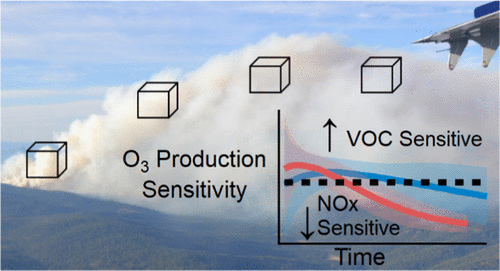当前位置:
X-MOL 学术
›
Environ. Sci. Technol.
›
论文详情
Our official English website, www.x-mol.net, welcomes your feedback! (Note: you will need to create a separate account there.)
Variability and Time of Day Dependence of Ozone Photochemistry in Western Wildfire Plumes
Environmental Science & Technology ( IF 11.4 ) Pub Date : 2021-07-13 , DOI: 10.1021/acs.est.1c01963 Michael A Robinson 1, 2, 3 , Zachary C J Decker 1, 2, 3 , Kelley C Barsanti 4 , Matthew M Coggon 1, 2 , Frank M Flocke 5 , Alessandro Franchin 1, 2 , Carley D Fredrickson 6 , Jessica B Gilman 1 , Georgios I Gkatzelis 1, 2 , Christopher D Holmes 7 , Aaron Lamplugh 1, 2 , Avi Lavi 4 , Ann M Middlebrook 1 , Denise M Montzka 5 , Brett B Palm 6 , Jeff Peischl 1, 2 , Brad Pierce 8 , Rebecca H Schwantes 1, 2 , Kanako Sekimoto 9 , Vanessa Selimovic 10 , Geoffrey S Tyndall 5 , Joel A Thornton 6 , Paul Van Rooy 4 , Carsten Warneke 1 , Andrew J Weinheimer 5 , Steven S Brown 1, 3
Environmental Science & Technology ( IF 11.4 ) Pub Date : 2021-07-13 , DOI: 10.1021/acs.est.1c01963 Michael A Robinson 1, 2, 3 , Zachary C J Decker 1, 2, 3 , Kelley C Barsanti 4 , Matthew M Coggon 1, 2 , Frank M Flocke 5 , Alessandro Franchin 1, 2 , Carley D Fredrickson 6 , Jessica B Gilman 1 , Georgios I Gkatzelis 1, 2 , Christopher D Holmes 7 , Aaron Lamplugh 1, 2 , Avi Lavi 4 , Ann M Middlebrook 1 , Denise M Montzka 5 , Brett B Palm 6 , Jeff Peischl 1, 2 , Brad Pierce 8 , Rebecca H Schwantes 1, 2 , Kanako Sekimoto 9 , Vanessa Selimovic 10 , Geoffrey S Tyndall 5 , Joel A Thornton 6 , Paul Van Rooy 4 , Carsten Warneke 1 , Andrew J Weinheimer 5 , Steven S Brown 1, 3
Affiliation

|
Understanding the efficiency and variability of photochemical ozone (O3) production from western wildfire plumes is important to accurately estimate their influence on North American air quality. A set of photochemical measurements were made from the NOAA Twin Otter research aircraft as a part of the Fire Influence on Regional to Global Environments and Air Quality (FIREX-AQ) experiment. We use a zero-dimensional (0-D) box model to investigate the chemistry driving O3 production in modeled plumes. Modeled afternoon plumes reached a maximum O3 mixing ratio of 140 ± 50 ppbv (average ± standard deviation) within 20 ± 10 min of emission compared to 76 ± 12 ppbv in 60 ± 30 min in evening plumes. Afternoon and evening maximum O3 isopleths indicate that plumes were near their peak in NOx efficiency. A radical budget describes the NOx volatile - organic compound (VOC) sensitivities of these plumes. Afternoon plumes displayed a rapid transition from VOC-sensitive to NOx-sensitive chemistry, driven by HOx (=OH + HO2) production from photolysis of nitrous acid (HONO) (48 ± 20% of primary HOx) and formaldehyde (HCHO) (26 ± 9%) emitted directly from the fire. Evening plumes exhibit a slower transition from peak NOx efficiency to VOC-sensitive O3 production caused by a reduction in photolysis rates and fire emissions. HOx production in evening plumes is controlled by HONO photolysis (53 ± 7%), HCHO photolysis (18 ± 9%), and alkene ozonolysis (17 ± 9%).
中文翻译:

西部野火羽流中臭氧光化学的变异性和时间依赖性
了解西部野火羽流产生的光化学臭氧 (O 3 )的效率和可变性对于准确估计它们对北美空气质量的影响非常重要。作为火灾对区域到全球环境和空气质量的影响 (FIREX-AQ) 实验的一部分,从 NOAA 双水獭研究飞机上进行了一组光化学测量。我们使用零维 (0-D) 盒模型来研究驱动模拟羽流中O 3产生的化学反应。模拟的下午羽流在排放的 20 ± 10 分钟内达到140 ± 50 ppbv(平均 ± 标准偏差)的最大 O 3混合比,而傍晚羽流中的 76 ± 12 ppbv 在 60 ± 30 分钟内。下午和晚上最大 O 3等值线表明羽流接近其 NO x效率的峰值。激进预算描述了这些羽流的 NO x挥发性有机化合物 (VOC) 敏感性。下午羽状显示从到NO VOC敏感的快速转变X敏感的化学,由HO驱动X(= OH + HO 2)从亚硝酸的光解(HONO)生产(48±初级HO的20%X)和甲醛( HCHO) (26 ± 9%) 直接从火中排放。由于光解速率和火灾排放的降低,晚间羽流表现出从峰值 NO x效率到 VOC 敏感的 O 3生成的较慢过渡。过氧化氢 晚羽的产生由 HONO 光解 (53 ± 7%)、HCHO 光解 (18 ± 9%) 和烯烃臭氧分解 (17 ± 9%) 控制。
更新日期:2021-08-03
中文翻译:

西部野火羽流中臭氧光化学的变异性和时间依赖性
了解西部野火羽流产生的光化学臭氧 (O 3 )的效率和可变性对于准确估计它们对北美空气质量的影响非常重要。作为火灾对区域到全球环境和空气质量的影响 (FIREX-AQ) 实验的一部分,从 NOAA 双水獭研究飞机上进行了一组光化学测量。我们使用零维 (0-D) 盒模型来研究驱动模拟羽流中O 3产生的化学反应。模拟的下午羽流在排放的 20 ± 10 分钟内达到140 ± 50 ppbv(平均 ± 标准偏差)的最大 O 3混合比,而傍晚羽流中的 76 ± 12 ppbv 在 60 ± 30 分钟内。下午和晚上最大 O 3等值线表明羽流接近其 NO x效率的峰值。激进预算描述了这些羽流的 NO x挥发性有机化合物 (VOC) 敏感性。下午羽状显示从到NO VOC敏感的快速转变X敏感的化学,由HO驱动X(= OH + HO 2)从亚硝酸的光解(HONO)生产(48±初级HO的20%X)和甲醛( HCHO) (26 ± 9%) 直接从火中排放。由于光解速率和火灾排放的降低,晚间羽流表现出从峰值 NO x效率到 VOC 敏感的 O 3生成的较慢过渡。过氧化氢 晚羽的产生由 HONO 光解 (53 ± 7%)、HCHO 光解 (18 ± 9%) 和烯烃臭氧分解 (17 ± 9%) 控制。


























 京公网安备 11010802027423号
京公网安备 11010802027423号